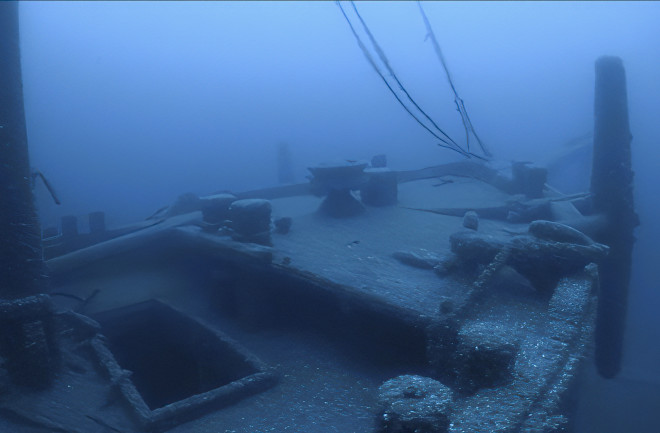The cold freshwater in Lake Huron kept the sunken ship Ironton intact for over a century — including all three of its masts and a lifeboat that took five lives — but also brought the ship’s destruction.
The Ironton sank in September 1894 after colliding with a steamer ship named the Ohio. The sunken ship had been missing for around 120 years with only rumors of its location. Recently, researchers from the state of Michigan, the Ocean Exploration Trust and NOAA discovered the ship in what is known as Shipwreck Alley.
“Discoveries like this are fascinating because they connect people to Michigan’s long history of maritime innovation and commerce. The more we discover, the more we understand the lives of the men and women who worked the Great Lakes,” says Sandra Clark, director of Michigan History Center and co-manager of Thunder Bay National Marine Sanctuary in a statement.
Shipwreck Alley
Thunder Bay got its name, “Shipwreck Alley,” because of the nasty storms that were common in the area — 12 ships sank from a single storm in 1913, which claimed 248 lives — and because of the congestion of trade ships. Ships used this canal to transport goods such as wheat, coal, corn, lumber and iron ore, and since it came to a choke point, many ships converged within a small area.
Today, the Thunder Bay National Marine Sanctuary protects nearly 100 of these historic shipwrecks in Lake Huron, giving insight to the commercial shipping industry that lasted 200 years.
Read More: No One Knows How Many Shipwrecks Exist, So How Do We Find Them?
What Happened to the Ironton
Hundreds of feet below the water’s surface, the Ironton is one of the historical shipwrecks that the sanctuary protects. The ship itself is 191 feet long and 772 tons, which can carry around 1,250 tons of coal.
The vessel was in transport for 22 years before the night of the wreck. On Sept. 26, 1894, the steamer that was pulling the then-empty Ironton suddenly had a failed engine. To avoid colliding with the disabled steamer, the Ironton cut the tow line. But Lake Huron’s wind-blown seas led the ship straight towards the Ohio, causing a head-on collision.
The Ironton sank as it drifted out of sight. Nearby sailors rescued the 16 crew members on the Ohio who escaped on lifeboats. But the lifeboat for the Ironton did little saving.
As the Ironton sank, all seven crew members climbed aboard the lifeboat, but it was still tethered to the vessel as it went down. Only two crew members survived, clinging to a sailor’s bag and a box before a passing steamer could rescue them.
In the discovery of the Ironton, researchers found the lifeboat still attached to the vessel.
Read More: Revisiting the Atlanta: Why Shipwrecks are so Common on the Great Lakes
What the Ironton Tells Us
Using the latest innovation in underwater mapping technology, the Thunder Bay National Marine Sanctuary along with the Ocean Exploration Trust set out to find the sunken vessel in 2019. Researchers had found the Ohio in 2017, which helped direct the mapping expedition to the Ironton.
"The discovery illustrates how we can use the past to create a better future," says Jeff Gray, Thunder Bay National Marine Sanctuary superintendent in a statement.
An underwater robot confirmed the ship’s identity, and the team returned to the site in 2021 to investigate more.
What they discovered was a complete ship resting upright, preserved by the freshwater.
"We have not only located a pristine shipwreck lost for over a century, we are also learning more about one of our nation's most important natural resources — the Great Lakes. This research will help protect Lake Huron and its rich history,” says Gray in a statement.
Read More: Shipwrecks, Volcanic Ash And Lost Cities Come To The Surface In Lake Mead






